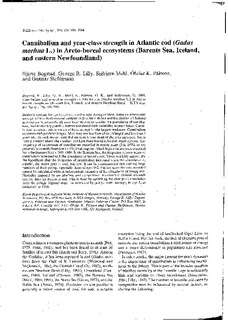| dc.contributor.author | Bogstad, Bjarte | |
| dc.contributor.author | Lilly, George R. | |
| dc.contributor.author | Mehl, Sigbjørn | |
| dc.contributor.author | Palsson, Olafur K. | |
| dc.contributor.author | Stefánsson, Gunnar | |
| dc.date.accessioned | 2008-07-11T07:28:17Z | |
| dc.date.issued | 1994 | |
| dc.identifier.issn | 0906-060X | |
| dc.identifier.uri | http://hdl.handle.net/11250/107973 | |
| dc.description.abstract | Stomach content data collected from cod caught during offshore resource assessment
surveys in three Arcto-boreal ecosystems (the Barents Sea and the shelves off Iceland
and eastern Newfoundland) were examined to determine the prevalence of cannibalism,
and to identify possible factors associated with variability in prevalence. Cannibalism
provides a minor source of food, except for the largest predators. Cannibalism
Increases with predator length. Most prey are less than 40 cm In length and less than 3
years old. In each region, cannibalism occurs over most of the area surveyed, but is
most prevalent where the smallest cod have been found in bottom trawl surveys. The
frequency of occurrence of cannibalism recorded in recent years (late 1970s to the
present) has usually been low ( | en |
| dc.format.extent | 1147816 bytes | |
| dc.format.mimetype | application/pdf | |
| dc.language.iso | eng | en |
| dc.relation.ispartofseries | ICES Marine Science Symposia | en |
| dc.relation.ispartofseries | 198 | en |
| dc.title | Cannibalism and year-class strength in Atlantic cod (Gadus morhua L.) in Arcto-boreal ecosystems (Barents Sea, Iceland, and eastern Newfoundland) | en |
| dc.type | Journal article | en |
| dc.type | Peer reviewed | |
| dc.subject.nsi | VDP::Agriculture and fishery disciplines: 900::Fisheries science: 920::Aquaculture: 922 | en |
| dc.source.journal | ICES Marine Science Symposia | |
